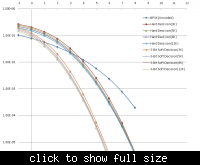insatiable
Junior Member level 2
traceback depth
hi all:
my question is about the traceback in the Convolutional Coding. as we know, a typical value for traceback depeth is about five times the constraint length of the code. Any deeper traceback increases decoding delay and decoder memory requirements, while not significantly improving the performance of the decoder.
the codes below are example of the Convolutional Coding in matlab help file. the function 'vitdec' is used to decode. here i do not know why the traceback is '34' and '96' respectively. can anyone explain the reason?
1.
len = 1000;
msg = randint(2*len,1); % Random binary message of 2-bit symbols
trel = poly2trellis([5 4],[23 35 0;0 5 13]); % Trellis
code = convenc(msg,trel); % Encode the message.
ncode = rem(code + randerr(3*len,1,[0 1;.96 .04]),2); % Add noise.
decoded = vitdec(ncode,trel,34,'cont','hard'); % Decode.
[number,ratio] = biterr(decoded(68+1:end),msg(1:end-68));
2.
len = 30000; msg = randi([0 1], len, 1); % Random data
t = poly2trellis(7, [133 171]); % Define trellis.
punctcode = convenc(msg, t, [1 1 1 0 0 1]); % Length is (2*len)*2/3.
tcode = 1-2*punctcode; % Map "0" bit to 1 and "1" bit to -1
ncode = awgn(tcode, 3, 'measured'); % Add noise.
% Decode the punctured code
decoded = vitdec(ncode, t, 96, 'trunc', 'unquant', [1 1 1 0 0 1]); % Decode.
[numErrP, berP] = biterr(decoded, msg); % Bit error rate
% Erase the least reliable 100 symbols, then decode
[dummy idx] = sort(abs(ncode));
erasures = zeros(size(ncode)); erasures(idx(1:100)) = 1;
decoded = vitdec(ncode, t, 96, 'trunc', 'unquant', [1 1 1 0 0 1], erasures); % Decode.
[numErrPE, berPE] = biterr(decoded, msg); % Bit error rate
fprintf('Number of errors with puncturing: %d\n', numErrP)
fprintf('Number of errors with puncturing and erasures: %d\n', numErrPE)
hi all:
my question is about the traceback in the Convolutional Coding. as we know, a typical value for traceback depeth is about five times the constraint length of the code. Any deeper traceback increases decoding delay and decoder memory requirements, while not significantly improving the performance of the decoder.
the codes below are example of the Convolutional Coding in matlab help file. the function 'vitdec' is used to decode. here i do not know why the traceback is '34' and '96' respectively. can anyone explain the reason?
1.
len = 1000;
msg = randint(2*len,1); % Random binary message of 2-bit symbols
trel = poly2trellis([5 4],[23 35 0;0 5 13]); % Trellis
code = convenc(msg,trel); % Encode the message.
ncode = rem(code + randerr(3*len,1,[0 1;.96 .04]),2); % Add noise.
decoded = vitdec(ncode,trel,34,'cont','hard'); % Decode.
[number,ratio] = biterr(decoded(68+1:end),msg(1:end-68));
2.
len = 30000; msg = randi([0 1], len, 1); % Random data
t = poly2trellis(7, [133 171]); % Define trellis.
punctcode = convenc(msg, t, [1 1 1 0 0 1]); % Length is (2*len)*2/3.
tcode = 1-2*punctcode; % Map "0" bit to 1 and "1" bit to -1
ncode = awgn(tcode, 3, 'measured'); % Add noise.
% Decode the punctured code
decoded = vitdec(ncode, t, 96, 'trunc', 'unquant', [1 1 1 0 0 1]); % Decode.
[numErrP, berP] = biterr(decoded, msg); % Bit error rate
% Erase the least reliable 100 symbols, then decode
[dummy idx] = sort(abs(ncode));
erasures = zeros(size(ncode)); erasures(idx(1:100)) = 1;
decoded = vitdec(ncode, t, 96, 'trunc', 'unquant', [1 1 1 0 0 1], erasures); % Decode.
[numErrPE, berPE] = biterr(decoded, msg); % Bit error rate
fprintf('Number of errors with puncturing: %d\n', numErrP)
fprintf('Number of errors with puncturing and erasures: %d\n', numErrPE)
